From the start Flaco existed in two realities: the park and online.
Flaco: A Triptych
By David Gessner
Read all three parts of this series:
Imagine Flaco, the escaped Eurasian eagle-owl, flying through Central Park after dark.
Owls are known as the lords of the night, but it is during the crepuscular hours that they truly reign. Flaco would have flown silently, his wings holding an evolutionary secret that humans had long noted but not understood. Those wings are made up of feathers that, unlike other birds, reduce turbulence and the noise it brings, and are coated with pennula, fibers that muffle sound. When Canada geese or even swans fly overhead you hear the loud whoosh and flap of their wings. Not so owls (though if you are close enough the whoosh of displaced air can’t be disguised).
Though everything was new in the park, Flaco’s eyes—enormous, round, forward-facing like a human’s but making up a staggering five percent of his body weight—were another great advantage. This was thanks to a layer of tissue called the tapetum lucidum, a retroreflector, or kind of internal mirror that reflects visible light back through the retina, and to the fact that those eyes are packed full of retinal cones.
While Flaco’s eyes might have been his most obvious and arresting feature, it is the organ they work in concert with, his ears, that are even more subtly dramatic. Not the flamboyant tufts that gave the bird a horned look but don’t actually aid in hearing, but the ears themselves. Slightly asymmetrical, with sound reaching one a millisecond or two sooner, they allow owls to home in on their prey’s exact location and, working in conjunction with those magnificent eyes, find that prey in near total darkness.
These were the tools that evolution had gifted Flaco with.
The problem was that he had not yet learned how to fully use those tools.
Disuse, being hand fed and unable to fly more than a few yards from side to side, had stripped him of his instinctive abilities.
What was fascinating in those early weeks after his escape was the story of growth, of evolution, of watching him regain those native skills.
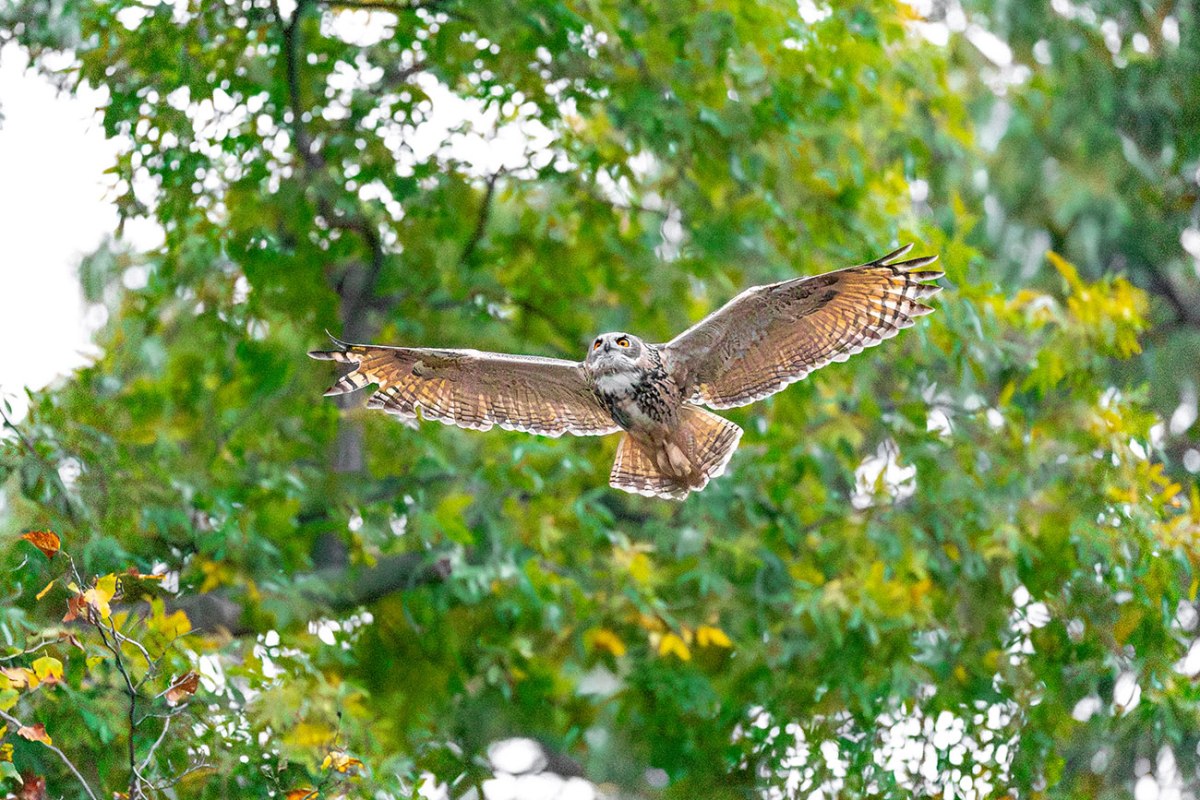
His first explorations were short and tentative. He stayed close to the Hallet Sanctuary on the southern edge of the park, perched high amid a small forest of beech, ash, locust, cherry, black oak, and sassafras, all the trees still February barren except for the occasional evergreen hollies and inkberries. With the branches bare, the first wave of human Flaco watchers had a clear view of not just the bird but of buildings, like the historic Essex House, rising behind him. The red-winged blackbirds, harbingers of spring, were not quite back yet, but over those first days Flaco encountered his fellow free birds: chittering sparrows and one irksome red-tailed hawk who edged in pretty close. This was clearly a different life than the one in his cage.
But while it was a new life, one similarity with his old one was that there were always eyes on him. More eyes, eventually, than when he was in his cage. Despite the Arctic cold of his first free morning, a crowd of bird watchers pointed their binoculars up at him. Even that early the narratives had begun to flow and intermix. There was worry about the extreme cold, but that was countered by experts pointing out that some wild eagle owls called the Arctic their home. By the second day a larger concern was that the bird had made no effort to feed himself, not even tempted by the food the zooworkers had laid out on the ground. Those zooworkers had not been cast as villains yet. The earliest tweets were concerned with his safety, focused on the hope that Flaco would be recaptured, but soon enough the word freedom began to creep into the dialogue.
A dramatic three weeks followed, all of it chronicled by David Barrett and others. From the start Flaco existed in two realities: the park and online. He was always both an actual bird and a virtual one, followed by foot and on screen. In this way he mirrored us, our funhouse mirror world, and his wildness was a curiously chronicled one, cultivated in decidedly un-wild ways. But if those who tracked him wielded cell phones and cameras, not spears or bows, the primitive thrill of the chase was real. And Flaco did not disappoint. His followers made note when he hooted among traffic noises on February 6th, and when he flew to the south end of the Literary Walk, the elm-lined promenade with statues of Shakespeare and Sir Walter Scott, on February 7th. That day he swooped unsuccessfully for a rat, then, on February 8th, he flew back to the Central Park Zoo and spent some time inside the crane exhibit.
Those who followed the owl took beautiful pictures and films in which you could (and still can) stare into the bird’s huge and perfectly round orange eyes, or watch the feathers on his proud black-flecked chest and ear tufts blowing in the cold February wind as he lifts his wings, stretching while high on a branch, taking mincing steps with massive taloned feet, and hooting of course, putting his whole self into it, moving his head forward as the white ruff below his mouth puffs out. Those who watched were impressed by his beauty and by his sheer size (and would have been more so had he been a she, females being the larger of this dimorphic species).
His followers worried that he had not yet caught a rat. And they worried he might catch one of the rats laid out by the rescue workers to trap him, though at that point most of the observers, including David Barrett, were rooting for Flaco to be returned to the safety of the zoo. Then on February 9th Flaco dove at a live rat that had been set out by the rescue workers and briefly got his feet tangled in netting meant to trap him, and once again the Flaco saga almost ended before it had really gotten going. The early days would be full of these close calls, with the Hallet Sanctuary closed to the public as they tried to lure the bird into a cage.
And then it happened.
It might not have made headlines in the Times, but it did in the world of Flaco. Owls are elegant birds in many ways, but not in their manners at the dinner table. They gorge and choke their prey down whole—fast and aggressively. Anything digestible continues on its journey down their digestive tract, but anything that is not—fur, bones, teeth—gets spit back out in a compact ball called a pellet.
And that was the big news, the headline of the Owl Gazette if such a publication existed, the cause for all the excitement within Team Flaco in mid-February.
Flaco had expelled a pellet!
The news shot like an electric current among those in the growing birding and online community.
“That was proof that he was able to obtain food for himself,” says David Barrett.
By mid-February, two weeks after Flaco’s escape, the public sentiment had begun welling behind a free Flaco, and the zoo started to waver in its commitment to capturing the owl. Whether or not this was in reaction to public sentiment is uncertain.
Worries about rat poison were counterbalanced by excitement about the chance that Flaco might just be able to make it outside his cage. The zoo, which until then had been intent on recapturing the bird, softened their stance, saying they would “continue to monitor him, though not as intensely, and look to opportunistically recover him when the situation is right.” But only five days later they set a baited trap in the Sheep Meadow and tried to lure Flaco in using a recording of a hooting female owl. “That was a bizarre night,” remembers Barrett, who was out following Flaco. Online outrage followed—“The nerve of them, the deceit!”—battle lines being quickly drawn. Speculation followed. Barrett posted that there was a rumor that an actual female eagle-owl might be used to lure Flaco in.
“It seemed like in those early days, the zoo was going back and forth a little bit,” David Barrett remembers. “So initially the zoo called off its recapture efforts, but only temporarily and mainly because they didn’t have the right equipment, I believe. And Flaco seemed to be alright. There was no overwhelming need to capture him.
“Roughly a week after his release, it was known that he could survive on his own. But that wasn’t the end of the trouble yet.”


Here is Jennifer Ackerman, one of our very best writers on birds:
“The name of the Eurasian eagle-owl evokes a hybrid mythical creature, half eagle, half owl, and that’s not too far from the truth.”
Later, in her book, What An Owl Knows, Ackerman speaks with Robyn Fleming, a research librarian at the Metropolitan Museum of Art, who described for her the history of owls in art from Goya to Picasso (who come to think it, had some pretty owly eyes). Of particular interest to Flaco fans might be the “huge Russian woodcut of a Eurasian eagle-owl” that Fleming discovered in storage in the basement of the museum.
Owl art goes back much further. There are the paintings of snowy owls on the walls of caves in Europe.
We are drawn to owls and have always been drawn to owls. The round eyes, the prominent ears, the large forward-facing head. Owls were with us from our artistic beginnings. In The Hidden Life of Owls, Leigh Calvez writes: “In Europe, hunter-gatherer people of the Stone Age carved a long-eared owl in the Chauvet Cave, home of the second-oldest cave paintings in France at about 32,400 years old.”
David Lei, a New York birder and photographer, works within this tradition, photographing owls in general and, for the last year, Flaco in particular. Lei would become one of the most steadfast and inspired of Flaco followers, producing hundreds of beautiful photos and dozens of films of the owl. On February 13th, he posted:
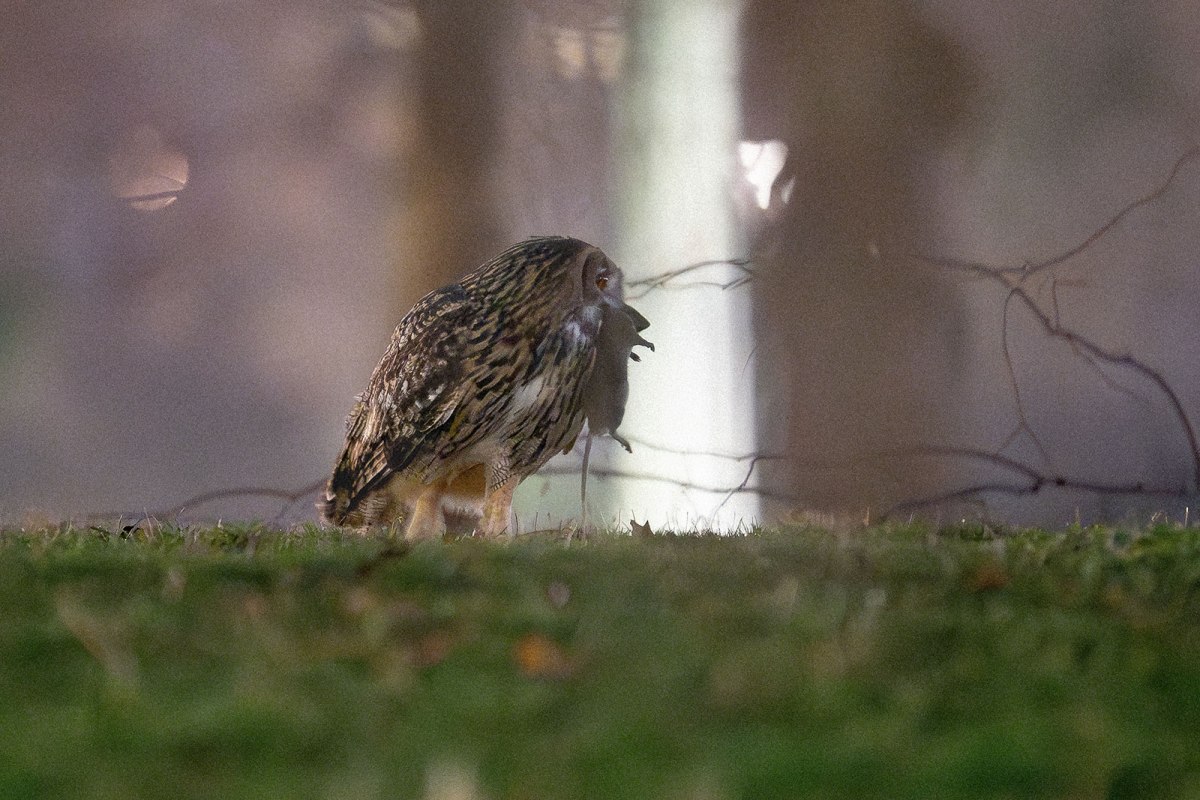
I first saw Flaco, the escaped Eurasian eagle-owl, hunt and eat Thursday night (pictured). Waited to share this so that it could get to the zoo staff first and allow them to adjust as needed. Flaco has been observed hunting each night since!
The previous Thursday would have been the 9th, the same day he had almost been caught in the trap, which meant in just once week Flaco had learned how to hunt.
Once it was clear that Flaco could hunt for himself the online narrative began to shift almost immediately, and the Free Flaco movement was born. At the same time many ornithologists warned of the dangers, both to and potentially from Flaco. On March 9th Audubon magazine scolded the freedom crew, stating unequivocally that the bird was in danger from a variety of urban threats, including rat poison, and was also a threat to native birds. It belonged back in its cage. Others noted that the cage itself was much smaller than that recommended for the species and that the only animal the owl seemed to be threatening was New York City rats. Even though Flaco would eventually succumb to rat poison and a pigeon virus, many point out that his life within the park was a healthy one. From the start debate circled around the bird. Things heated up on X, with plenty of attacks—attacks on the Flaco watchers for crowding the bird, attacks on the zoo for persisting with trying to catch him, and a few trollish attacks on David Barrett, made a target by virtue of the prominence of Manhattan Bird Alert, the central gathering place for Central Park birders. Scouring through the thousands of tweets and responses, I found that David Lei’s stand out for their general reasonableness of tone, a calm that doesn’t fall far short of wisdom. On February 13th he issued a series of posts as the Flaco hysteria heated up:
At the beginning of the weekend, there was elevated concern about Flaco. Reasonable concern from knowledgeable folks, false outrage from people seeking to generate likes and everything in between.
I think the simplest explanations for why Flaco hasn’t been rescued yet are the most likely and why the zoo is pausing rescue efforts: 1) He is in good health and adapted quickly to survival in the wild; and 2) he’s developed a taste for giant Central Park rats.
Then on February 16th Lei posted this picture and description:
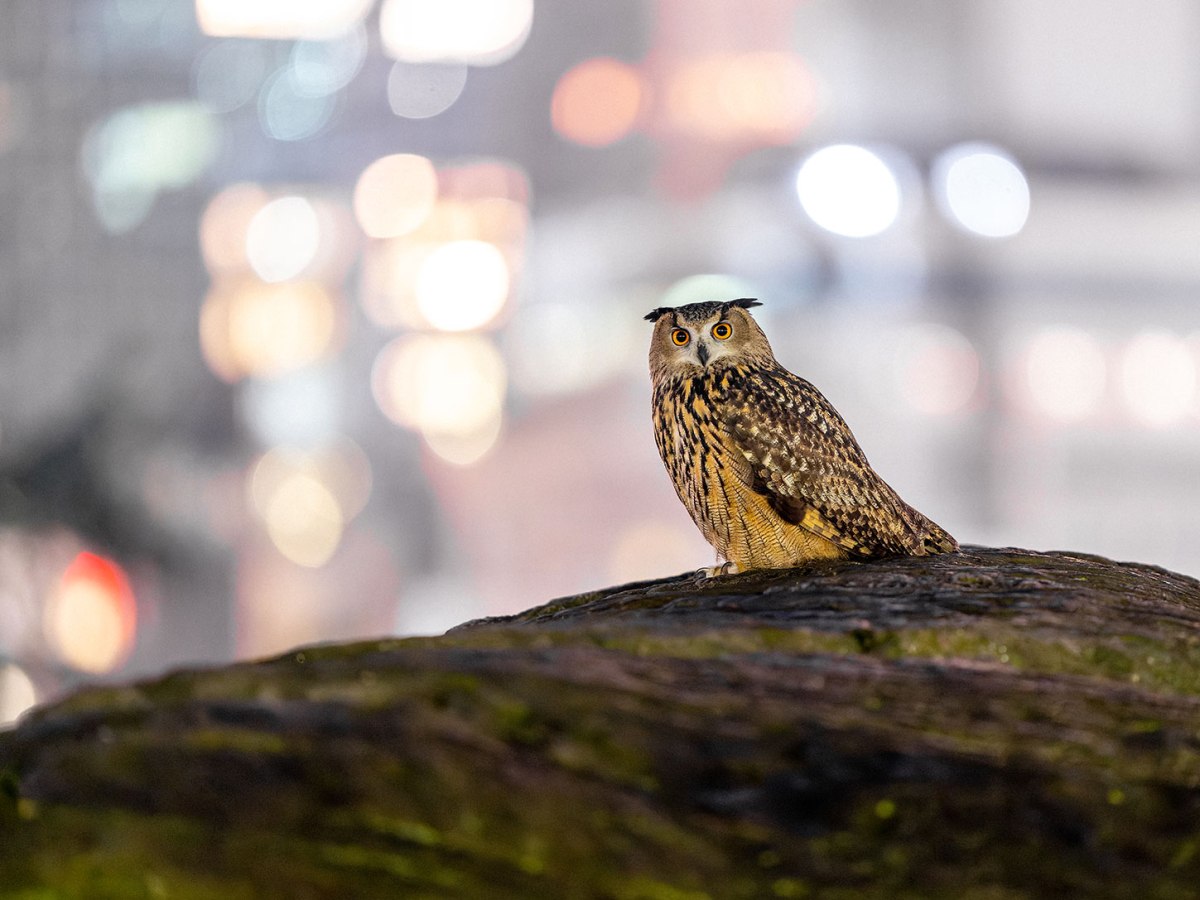
Flaco on a rock-o. Our escaped Eurasian eagle-owl has used Central Park’s rock formations in a way that his wild relatives overseas might use the rock outcroppings and cliffs of their preferred habitats. Lights of the Upper East Side in the background.
(A perfectly reasonable observation it seemed to me, but alas David had used the possessive at the beginning of the second sentence and one respondent scolded: “He’s not ‘yours.’”)
On February 22nd David Lei posted:
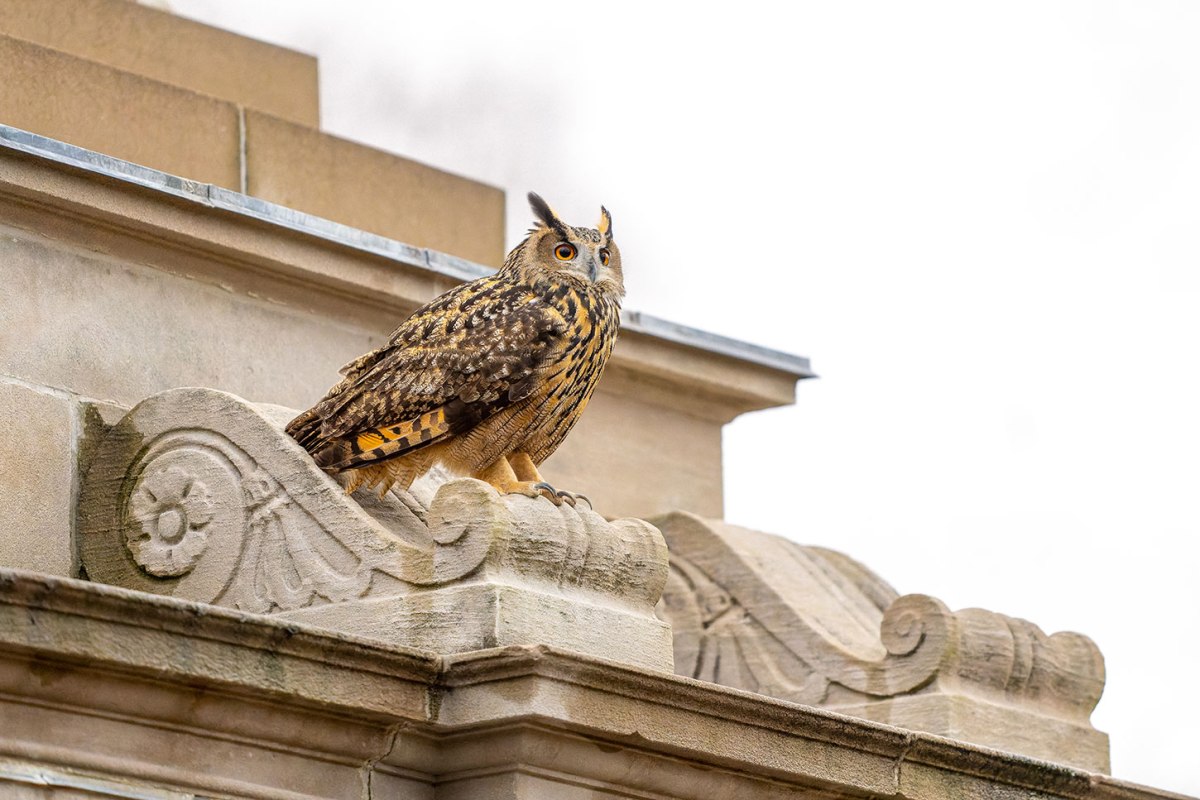
Flaco, the escaped Eurasian eagle-owl, perched on the Naumburg Bandshell last Friday night. Extreme opinions have been expressed about him. On this subject and others, perhaps we should behave more like owls: patiently watch and wait.


Picture an eagle-owl hunting in the wild. Sitting on a tree branch as dusk descends. Bobbing his head so that his satellite dish of a face can help direct sound toward those acute ears, peering out with those blazing orange eyes. And then he hears it, a faint rustling perhaps, a deer mouse under the leaf litter. His ears and eyes, working together, pinpoint the mouse’s exact location. At that moment the great bird drops silently from the tree with deep, slow wingbeats, powerful flaps up above his body. He drops lower, gliding toward the poor animal, diving down headfirst before kicking back with his powerful talons, crushing in with a violent burst. The mouse hears nothing until it is too late.
This was the image I had in my mind when I came to the Flaco story. But that was not how Flaco hunted, at least not at first. During those early days he did swoop for prey on the ground but unsuccessfully, and during his first known successful hunt, the one recorded by David Lei, he caught his rat by chasing after it on the ground. In fact hunting on foot remained his m.o. for most of the time until he left Central Park, though Lei reports seeing him hunt on the wing occasionally, “swooping for a rat, catching it, killing it in his talons and continuing on to another perch without landing.”
However, if his hunting remained somewhat rudimentary, his flight skills were improving dramatically. He was no longer exhausted after short bursts. By late February he had, according to Lei, “expanded his range and explored far to the north, even going undetected some days, and his flight skills were improving dramatically.”
Over at the Manhattan Bird Alert, David Barrett was singing the same song. He later summarized his thoughts for a publication called The West Side Rag: “Not only has he developed the skill and endurance to fly around the park, he looks graceful doing it. This after a lifetime of being forced to be mostly sedentary. He hoots, too! Probably both to indicate his territory and to find a mate.”
Barret continued: “After spending a couple days last week resting over his old home, the Central Park Zoo, he has moved on to explore the park. He seems to be enjoying his freedom, doing all the things a wild owl would be expected to do.”
Darker stories have been told in the wake of the grim necropsy report, with at least some of the early warnings proving true. But what we forget when we render these retrospective judgments is the sheer thrill of those early days. They were days of growth, of change, of evolution. And while it may be dangerous to attribute specific emotions to an animal, it is fair to say that, at least on a physical level, a kind of self-realization was occurring. Certainly Flaco was becoming more. Parts of him that had long slumbered were waking up.
Would it be going too far to say that as he got stronger Flaco took some pleasure in flight? Maybe. But in When Elephants Weep, Jeffrey Masson speculates that animals feel funktionslust, a German word meaning the “pleasure taken in what one can do best.” It must have been a release to fly without restriction, to travel more than the length of a department store display window through the air. To swoop. Many commentators chose the word “freedom” to describe Flaco’s experience, but as recent political trends have taught us, freedom is a slippery word. Space is less abstract, and space is what Flaco now had. “I love a broad margin to my life,” Thoreau said.
Perhaps owls do too.
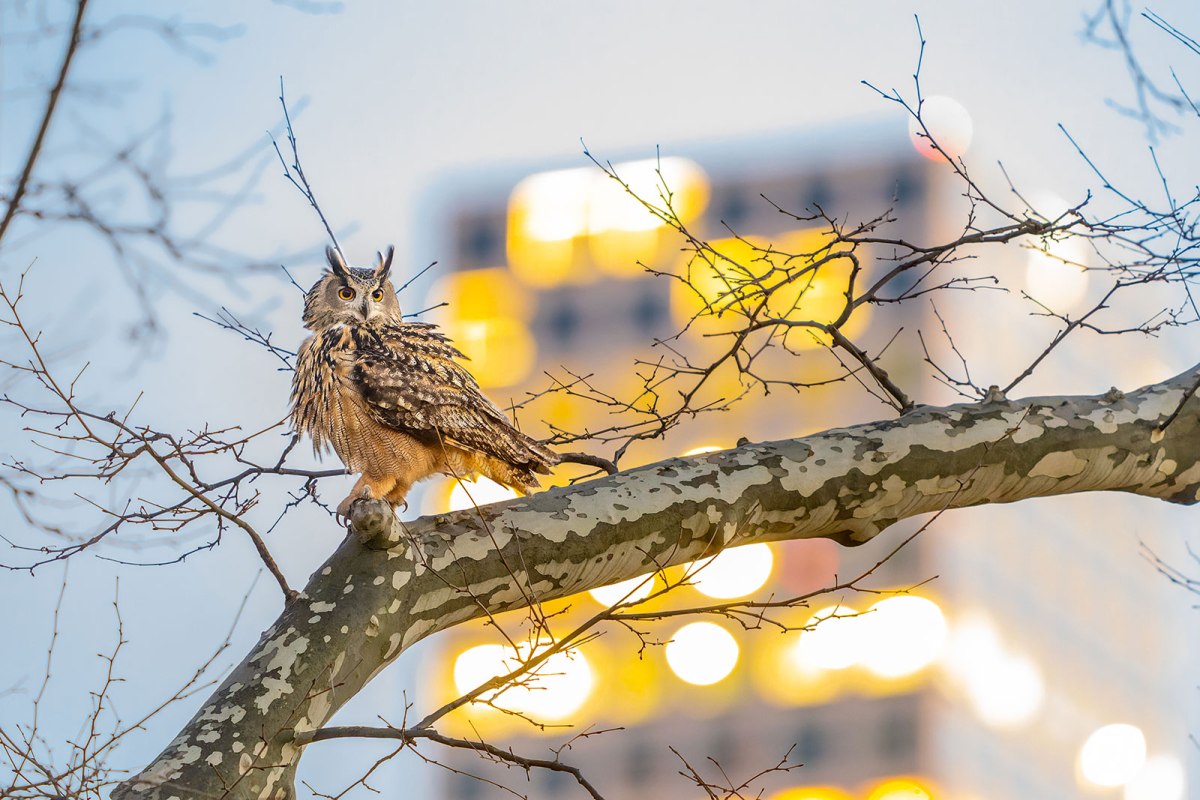
I happened to be in town, far from my home territory, in early March a month after Flaco escaped. I was there because my daughter Hadley was a freshman at NYU, having, like Flaco before her, moved from North Carolina to New York. My wife Nina and I spent the better part of a beautiful day in early March searching for the by-then-famous owl, exploring the park, especially the hills and hollows of the North Woods. Unbeknownst to us, we passed right by the tree that would become Flaco’s favorite, a black oak that grew straight up for 20 feet before spreading its branches out like an open hand. A year later I would return to that tree, only two days after the Flaco memorial, and find it surrounded by flowers, garden mums, Peruvian lilies, wild daffodils, tulips, carnations, and baby’s breath. Another strange fact I didn’t know at the time was that Flaco and I shared a birthday: the Ides of March.
In finding the North Woods it was Flaco’s good fortune that the territory he had discovered was remarkably like that his kind had evolved in over the eons, a forest of trees and rock ledges and water in the form of lakes and creeks and a small waterfall similar to the Eurasian forests that had helped make him who he was. True, the forest’s dimensions were not quite as vast as those where his ancestors had evolved—0.3 miles wide and 0.45 miles long—but in a city of 7.93 million people, you take what you can get.
During those weeks it wasn’t just the owl who was changing. Those who wanted to follow him during his active hours, and not just look up at him as he snoozed away the day, were becoming of necessity nocturnal hunters. They adjusted their schedules, transforming into day sleepers like the creature they were following. Excitement helped them cut down on sleep altogether. This included not just those tracking him on foot but a hungry pack of online followers, glued to their screens for updates. By then Flaco had become both a symbol and an individual that people had gotten to know, a powerful combination.
The North Woods, the Ramble, the Sheep Meadow, the Loch, the Harlem Meer. Exploring the park, his new territory, would be just the beginning. The park was not an enclosure and there was no steel mesh to keep him in. There was a world of concrete and skyscrapers to explore outside its borders and over the next year that too would become part of his territory.
To be continued in Part 3: Visitation…
Read Flaco: The Triptych ~ Part 1: The Escape.
 David Gessner is the author of A Traveler’s Guide to the End of the World: Tales of Fire, Wind, and Water, Quiet Desperation, Savage Delight: Sheltering with Thoreau in the Age of Crisis, Leave It As It Is: A Journey Through Theodore Roosevelt’s American Wilderness, and The New York Times-bestselling All the Wild That Remains: Edward Abbey, Wallace Stegner, and the American West. on the faculty of the Creative Writing Department at the University of North Carolina Wilmington, and founder and editor-in-chief of Ecotone, Gessner lives in Wilmington, North Carolina, with his wife, the novelist Nina de Gramont, and their daughter, Hadley.
David Gessner is the author of A Traveler’s Guide to the End of the World: Tales of Fire, Wind, and Water, Quiet Desperation, Savage Delight: Sheltering with Thoreau in the Age of Crisis, Leave It As It Is: A Journey Through Theodore Roosevelt’s American Wilderness, and The New York Times-bestselling All the Wild That Remains: Edward Abbey, Wallace Stegner, and the American West. on the faculty of the Creative Writing Department at the University of North Carolina Wilmington, and founder and editor-in-chief of Ecotone, Gessner lives in Wilmington, North Carolina, with his wife, the novelist Nina de Gramont, and their daughter, Hadley.
Read David Gessner’s Walks and Talks with Dave (and Henry) series, as well as “Abandoned Homes: A Triptuch” (an excerpt of A Traveler’s Guide to the End of the World), “Grizzled,” “Making a Name: Wallace Stegner,” and “Edward Abbey at Havasu,” all appearing in Terrain.org.
Header photo of Flaco the Eurasian eagle-owl by David Lei. Photo of David Gessner by Debi Lorenc.
- SEO Powered Content & PR Distribution. Get Amplified Today.
- PlatoData.Network Vertical Generative Ai. Empower Yourself. Access Here.
- PlatoAiStream. Web3 Intelligence. Knowledge Amplified. Access Here.
- PlatoESG. Carbon, CleanTech, Energy, Environment, Solar, Waste Management. Access Here.
- PlatoHealth. Biotech and Clinical Trials Intelligence. Access Here.
- Source: https://www.terrain.org/2024/nonfiction/flaco-part-2/

